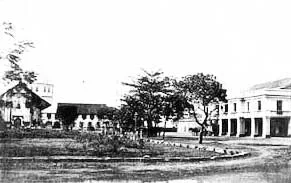The Folkloric Story of the Beginnings of Batangas City
The origins of today’s modern, large and still growing port city of Batangas, capital of the province of the same name, can only be reconstructed from folklore. To begin with, our forebears, although they had a form of writing, used this on materials that were very much perishable.
While the Spaniards, when they came, made records of their new environment, these were at best sketchy. It is to folklore, then, that we turn to learn more about the origins of today’s modern metropolis that is Batangas. One rich source is a document submitted by the local Department of Education district in compliance to President Elpidio Quirino’s directive in the early fifties to reconstruct local histories after documents were destroyed during the war1.
According to folklore reconstructed in this document, in 1572, a Spanish missionary came to a small lowland barangay or village along the Calumpang River. This bit of information is perfectly viable if not ultimately verifiable from documents. Although the conquistadores first glimpsed Luzon in 1570, two years later they had set up a pueblo near the lake called Bonbon which would over time become the town of Taal.
The pueblo in the context of the 16th century was a Christian settlement, and its creation was mandated by Spanish colonial law. The creation of these pueblos, therefore, fell on the shoulders of missionaries2. Therefore, it was perfectly plausible that there was indeed a missionary sent to scout the Calumpang River area as a possible site for the setting up of another pueblo.
That said, it would not be until after another six years since the foundation of Taal (1578) that another pueblo would also be founded in what is presently the city of Batangas. This is according to records kept by the Augustinian order, which was also responsible for the founding of several other settlements in Batangas3.
Returning to the folklore, though, the missionary, who would doubtless have been accompanied by Spanish soldiers, could only communicate with the natives using hand signs. Because he and the soldiers had no way of asking the natives what the name of the place was, they decided to call it “Kumintang” after the “melodious song sung everywhere by the natives.” How the Spaniards came to know that the song was “Kumintang,” but naturally the folklore did not say.
That there was, indeed, such as song is verifiable. The CCP Encyclopedia of Philippine Arts describes the kumintang as “dance-songs” performed by pairs of men and women and observed by early Spanish cartographers in the area which is now known as Batangas4.
Back to the folkloric story, the original settlement found along the Calumpang River was supposed to have grown so that “years later, the whole region around this river became called ‘Region del Cumintan’ by the Spaniards.” There is evidence of such a region or district with a similar-sounding name in Spanish documents.
In the “History of the Augustinian Order in the Philippine Islands,” one Fray Juan de Medina described a place called “Comintan” which encompassed the lands between the pueblos of Taal and Batangas. He described the lands as “excellent meadows” and that natives made use “of their domestic cattle on which they travel and carry their loads5.”
How the place the Spanish missionary in folklore called “Kumintang” became known as Batangan is explained by the Department of Education document. Supposedly, when a pueblo was officially founded in what used to be the village of “Kumintang,” the new town was “christened Batangan because of the numerous big logs that abounded there. Those logs were commonly called ‘batang’ by the people of the barangay.”
The word “batang” must be archaic Tagalog because the contemporary word for “log” is either “troso” or “kalap.” Assuming that the story was true, then Batangan must have simply meant “the place of the logs” or “where the logs are kept,” just as we say, in Tagalog, “babuyan” to mean “where the pigs are kept” and “manukan” to mean “where the chickens are kept.”
As the Spaniards organized governance of the Philippines in feudal style as was done in Europe in the 16th century, the large chunk of land from the lake called Bonbon all the way to Batangan was given as an encomienda (although the more correct term was repartimiento) to Mariscal (Marshall) Martin de Goite, who led the first Spanish expedition to explore Batangas and Luzon in 1570 under the orders of Miguel López de Legazpi6.
Batangan was assigned its first gobernadorcillo, one gentleman whose name was Don Agustin Casulao. What I am as yet unable to establish is how the name Batangan ultimately become Batangas; albeit I am aware that there are purists in the province to this day who prefer to refer to it by its old name.
2 “The Structure of Pueblos de Indios in the Philippines during the Spanish Colonial Period,” by Luis Ángel Sánchez Gómez, Madrid 1989. Online at Academia.
3 “Memoria acerca de las Misiones de los PP. Agustinos Calzados en las Islas Filipinas: presentada al Excmo. Sr. Ministro de Ultramar,” Madrid 1892
4 “Kumintang,” by E.R. Mirano citing the Encyclopedia of Philippine Arts as source, online at Tripod.com.
5 “History of the Augustinian Order in the Philippine Islands,” by Fray Juan de Medina OSA written 1630 published 1893. From the Blair and Robertson series the Philippine Islands Volume XXIV 1625 -1629.
6 “Encomiendas assigned by Legazpi,” as published in the Blair and Robertson series “The Philippine Islands Volume XXXIV: 1519-1522; 1280-1605.”

